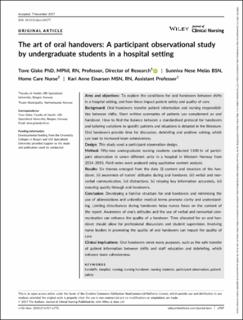| dc.contributor.author | Giske, Tove | |
| dc.contributor.author | Melås, Sunniva Nese | |
| dc.contributor.author | Einarsen, Kari Anne | |
| dc.date.accessioned | 2022-12-16T11:20:54Z | |
| dc.date.available | 2022-12-16T11:20:54Z | |
| dc.date.created | 2017-12-19T12:34:29Z | |
| dc.date.issued | 2018 | |
| dc.identifier.citation | Journal of Clinical Nursing. 2018, 27 (5-6), 883-1293, e712-e1241 | en_US |
| dc.identifier.issn | 0962-1067 | |
| dc.identifier.uri | https://hdl.handle.net/11250/3038254 | |
| dc.description | This is an open access article under the terms of the Creative Commons Attribution-NonCommercial-NoDerivs License, which permits use and distribution in any medium, provided the original work is properly cited, the use is non-commercial and no modifications or adaptations are made. | en_US |
| dc.description.abstract | Aims and objectives: To explore the conditions for oral handovers between shifts in a hospital setting, and how these impact patient safety and quality of care.
Background: Oral handovers transfer patient information and nursing responsibilities between shifts. Short written summaries of patients can complement an oral handover. How to find the balance between a standardised protocol for handovers and tailoring variations to specific patients and situations is debated in the literature. Oral handovers provide time for discussion, debriefing and problem solving, which can lead to increased team cohesiveness.
Design: This study used a participant observation design.
Method: Fifty-two undergraduate nursing students conducted 1100 hr of participant observation in seven different units in a hospital in Western Norway from 2014–2015. Field notes were analysed using qualitative content analysis.
Results: Six themes emerged from the data: (i) content and structure of the handover, (ii) awareness of nurses’ attitudes during oral handover, (iii) verbal and nonverbal communication, (iv) distractions, (v) relaying key information accurately, (vi) ensuring quality through oral handovers.
Conclusion: Developing a familiar structure for oral handovers and minimising the use of abbreviations and unfamiliar medical terms promote clarity and understanding. Limiting disturbances during handovers helps nurses focus on the content of the report. Awareness of one’s attitudes and the use of verbal and nonverbal communication can enhance the quality of a handover. Time allocated for an oral handover should allow for professional discussions and student supervision. Involving nurse leaders in promoting the quality of oral handovers can impact the quality of care. Clinical implications: Oral handovers serve many purposes, such as the safe transfer of patient information between shifts and staff education and debriefing, which enhance team cohesiveness. | en_US |
| dc.language.iso | eng | en_US |
| dc.publisher | Wiley | en_US |
| dc.rights | Attribution-NonCommercial-NoDerivatives 4.0 Internasjonal | * |
| dc.rights.uri | http://creativecommons.org/licenses/by-nc-nd/4.0/deed.no | * |
| dc.subject | patient safety | en_US |
| dc.subject | participant observation | en_US |
| dc.subject | nursing students | en_US |
| dc.subject | nursing handover | en_US |
| dc.subject | nursing | en_US |
| dc.subject | hospital | en_US |
| dc.subject | handoffs | en_US |
| dc.title | The art of oral handover: a participant observational study by undergraduate students in a hospital setting | en_US |
| dc.type | Peer reviewed | en_US |
| dc.type | Journal article | en_US |
| dc.description.version | acceptedVersion | en_US |
| dc.rights.holder | © 2017 The Authors. Journal of Clinical Nursing Published by John Wiley & Sons Ltd | en_US |
| dc.source.pagenumber | 883-1293, e712-e1241 | en_US |
| dc.source.volume | 27 | en_US |
| dc.source.journal | Journal of Clinical Nursing | en_US |
| dc.source.issue | 5-6 | en_US |
| dc.identifier.doi | 10.1111/jocn.14177 | |
| dc.identifier.cristin | 1529635 | |
| cristin.unitcode | 251,3,0,0 | |
| cristin.unitname | Fakultet for helsefag | |
| cristin.ispublished | true | |
| cristin.fulltext | postprint | |
| cristin.qualitycode | 2 | |

